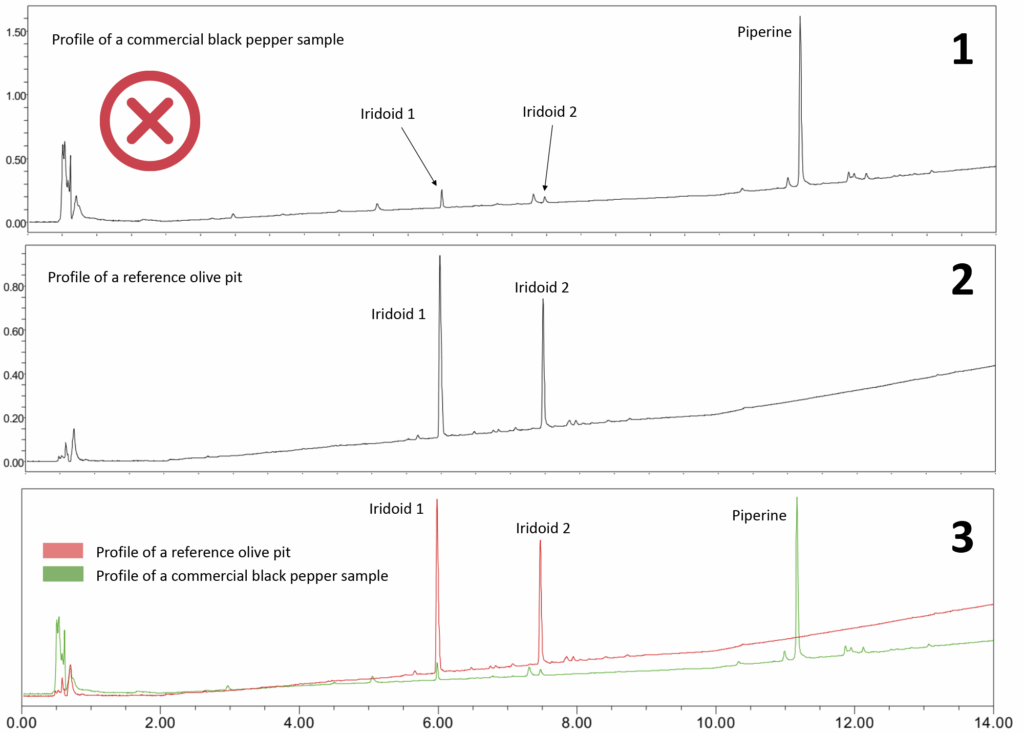Detection of adulteration in black pepper berries Piper nigrum (L.) with other plant species
Black pepper is one of the most widely used spices in households. It is often purchased in whole berry form and ground before use. In the agri-food sector or bulk plant trade, pepper is sold as whole berries, ground powder, or dry extracts.
Active compounds in black pepper
In dry extracts, the focus is on extracting piperine, an alkylamide and the major compound in black pepper. Piperine is responsible for the pepper’s pungent taste and is also linked to its beneficial properties, including antimicrobial and anti-inflammatory effects.
Black pepper adulteration
As with all processed products, the risk of adulteration is much greater. In the case of black pepper, there is a long history of adulteration that continues today: the use of olive pits. While this may seem rather crude, the fact that if it is still being used it is because the quality controls don’t detect it.
Indeed, as with all cases of adulteration by mixing with a contaminant, if the testing only looks for the presence of expected markers (in this case, piperine) the addition of the adulterant can never be detected. The study presented here outlines how to overcome this type of problem.
Standard control of a dry black pepper extract
As with all plants containing a high concentration of a single substance, quality control is usually based solely on the presence of this predominant molecule. However, such testing is insufficient. Indeed, if the analysis focuses only on the correct presence of the predominant compound (namely piperine) most cases of fraud, errors, or contamination will go undetected.


1: Piperine standard
2: Customer dry extract of Piper nigrum L.
3: Reference sample of Piper nigrum L. berries
| Cases that can be detected | Cases that cannot be detected |
|---|---|
| – Absence of black pepper and presence of another plant species that does not contain piperine (absence of piperine) – Extreme dilution of the extract (absence of piperine) – Presence of another species whose molecules will be detected by this analysis | – Unintentional presence of another species as a contaminant – Confusion with a closely related species – Intentional presence of another species as an adulterant – Enrichment with synthetic piperine |
It is clear that the vast majority of frauds and errors found on the market fall into the cases that cannot be detected by methods relying solely on the presence of a single compound. Detecting adulteration with olive pits is therefore impossible using such an approach. So, what is the point of carrying out this type of test? The value is purely regulatory, because from a risk analysis perspective, this test does not reduce the potential risks associated with this raw material.
Detection of fraudulent compounds in samples
To detect adulteration of black pepper with olive pits, it is necessary to look for markers of both black pepper and olive pits. Using a more comprehensive compositional analysis, as shown in the chromatograms below, unexpected compounds in a black pepper sample can be quickly identified, revealing the presence of a mixture of black pepper and olive pits.

2: UHPLC-DAD profile (190–600 nm) of a reference sample of Olea europaea L. pits
3: Overlay of the two UHPLC-DAD profiles above: commercial black pepper (green) and olive pits (red)
An untargeted analysis to identify all types of black pepper adulteration
Using the characteristic compounds of olive pits is therefore not a solution. Indeed, if we focus once again on a single marker, we can only conclude that the specific target marker is present or not. In this case, it only confirms whether olive pits are absent from the black pepper sample. But what about other potential adulterations?
The solution is to perform an untargeted analysis, as this would reveal unexpected markers and therefore, all types of adulteration.
Performing an inadequate inspection (such as a simple check for the presence of piperine) may prove too limited, especially considering that frauds are often subtle and difficult to detect.
How can you ensure the quality of your black pepper samples?
By confirming the presence of black pepper, the absence of other species that could be used as adulterants, and by measuring piperine as the target marker.